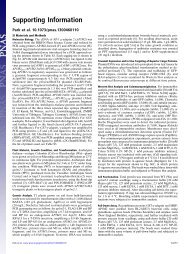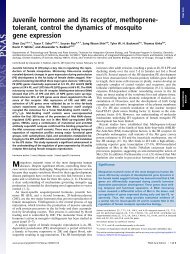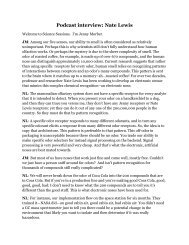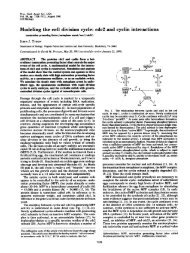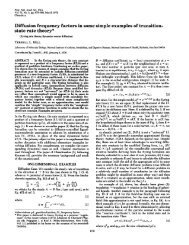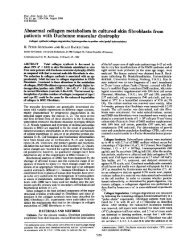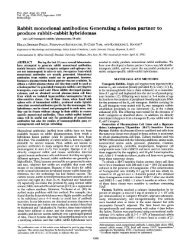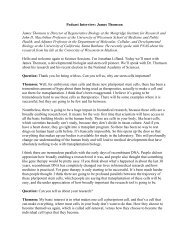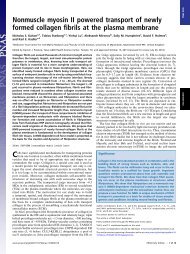Phylogenetic classification of life - Proceedings of the National ...
Phylogenetic classification of life - Proceedings of the National ...
Phylogenetic classification of life - Proceedings of the National ...
You also want an ePaper? Increase the reach of your titles
YUMPU automatically turns print PDFs into web optimized ePapers that Google loves.
Proc. Natl. Accad. Sci. USA<br />
Vol. 93, pp. 1071-1076, February 1996<br />
Evolution<br />
Archaeal- eubacterial mergers in <strong>the</strong> origin <strong>of</strong> Eukarya:<br />
<strong>Phylogenetic</strong> <strong>classification</strong> <strong>of</strong> <strong>life</strong><br />
(centriole-kinetosome DNA/Protoctista/kingdom <strong>classification</strong>/symbiogenesis/archaeprotist)<br />
LYNN MARGULIS<br />
Department <strong>of</strong> Biology, University <strong>of</strong> Massachusetts, Amherst, MA 01003-5810<br />
Conitribluted by Lynnl Marglulis, September 15, 1995<br />
ABSTRACT A symbiosis-based phylogeny leads to a consistent,<br />
useful <strong>classification</strong> system for all <strong>life</strong>. "Kingdoms"<br />
and "Domains" are replaced by biological names for <strong>the</strong> most<br />
inclusive taxa: Prokarya (bacteria) and Eukarya (symbiosisderived<br />
nucleated organisms). The earliest Eukarya, anaerobic<br />
mastigotes, hypo<strong>the</strong>tically originated from permanent<br />
whole-cell fusion between members <strong>of</strong> Archaea (e.g., Thermoplasma-like<br />
organisms) and <strong>of</strong> Eubacteria (e.g., Spirochaetalike<br />
organisms). Molecular biology, <strong>life</strong>-history, and fossil<br />
record evidence support <strong>the</strong> reunification <strong>of</strong> bacteria as<br />
Prokarya while subdividing Eukarya into uniquely defined<br />
subtaxa: Protoctista, Animalia, Fungi, and Plantae.<br />
Bacterial Symbioses Form Cells <strong>of</strong> Eukarya<br />
Here I detail implications <strong>of</strong> serial endosymbiotic <strong>the</strong>ory (SET;<br />
ref. 1) <strong>of</strong> origins <strong>of</strong> nucleated organisms for interpretation <strong>of</strong><br />
molecular data and <strong>classification</strong> <strong>of</strong> all <strong>life</strong>. Eukaryotes evolved<br />
when archaeal (2) (=archaebacterial) and eubacterial cells<br />
merged in ahaerobic symbiosis. Nucleocytoplasm (from Archaea)<br />
acquired swimming motility (from fermenting Eubacteria)<br />
becoming mastigotes prior to acquisition <strong>of</strong> mitochondria<br />
or plastids (3, 4). Some mastigotes <strong>the</strong>n incorporated<br />
purple Eubacteria (mitochondria precursors) to become oxygen-respiring<br />
aerobes from which most protoctists, animals,<br />
and fungi evolved. Aerobes in later permanent association with<br />
plastid-precursor cyanobacteria became algae-i.e., phototrophic<br />
protoctists (5).<br />
Individuality reappears as former symbionts integrate and<br />
branches on bifurcating phylogenies anastomose to generate<br />
new name-requiring taxa. The necessary and sufficient explanation<br />
<strong>of</strong> simultaneous archaeal and eubacterial protein and<br />
nucleic acid sequences (refs. 2, 5-13; Table 1) even in amitochondriate<br />
eukaryotes is <strong>the</strong>ir origin as genetically integrated<br />
bacterial symbionts. The consequences <strong>of</strong> <strong>the</strong> SET phylogeny<br />
for systematics (evolutionary <strong>classification</strong>) includes replacement<br />
<strong>of</strong> ad hoc gene transfer hypo<strong>the</strong>ses (10), social-political<br />
terms like Kingdom or Domain (2), and o<strong>the</strong>r confusion with<br />
a consistent taxonomy for identifying, naming, and classifying<br />
all <strong>life</strong>.<br />
Comparable to extant prokaryotic consortia-e.g., Thiodendron<br />
(15), Methanobacillus omelianski (16), and Daptobacterinfected<br />
chromatia (17)-<strong>the</strong> earliest symbioses that became<br />
eukaryotic cells lacked mitosis and meiosis. Abiding in anoxic<br />
environments today are free-living amitochondriate motile<br />
heterotrophs, mastigotes, related to animal intestinal symbionts<br />
(18, 19). They vary in number <strong>of</strong> nuclei, organization <strong>of</strong><br />
chromatin, kinetochores, Golgi-parabasal bodies, rhizoplast<br />
nucleus-kinetosome connectors, [9(2)+21 microtubule-based<br />
intracellular motility organelles (undulipodia), centriolekinetosome-mitotic<br />
spindles, and meiotic sexuality, suggesting<br />
The publication costs <strong>of</strong> this article were defrayed in part by page charge<br />
payment. This articlc must <strong>the</strong>refore be hereby marked "advertisement" in<br />
accordance with 18 U.S.C. §1734 solely to indicate this fact.<br />
1071<br />
<strong>the</strong>se features evolved in <strong>the</strong>ir ancestors by inferable steps (4,<br />
20). rRNA gene sequences (Trichomonas, Coronympha, Giardia;<br />
ref. 11) confirm <strong>the</strong>se as descendants <strong>of</strong> anaerobic eukaryotes<br />
that evolved prior to <strong>the</strong> "crown group" (12)-e.g.,<br />
animals, fungi, or plants.<br />
If eukaryotes began as motility symbioses between Archaea-e.g.,<br />
Thermoplasma acidophilum-like and Eubacteria<br />
(Spirochaeta-, Spirosymplokos-, or Diplocalyx-like microbes;<br />
ref. 4) where cell-genetic integration led to <strong>the</strong> nucleuscytoskeletal<br />
system that defines eukaryotes (21)-<strong>the</strong>n an<br />
optimal explanation for Table I's large quantity <strong>of</strong> o<strong>the</strong>rwise<br />
baffling sequence data ensues (Table 2).<br />
Nucleoid membranes are known in at least one prokaryote,<br />
Gemmata obscuriglobus (24), and membrane hypertrophy is<br />
common in invasive associations implying nuclear-endomembrane<br />
systems originated as defensive response in bacterial<br />
mergers (4). Centriole-kinetosomes are thought derived from<br />
attached eubacteria (Fig. 1) such that centriole-kinetosome<br />
DNA (c-kDNA; refs. 25 and 26) is <strong>the</strong>ir vestige (4, 21).<br />
A great distinction is made between prokaryotic genomes no<br />
matter <strong>the</strong>ir recombinant source or number per cell (e.g.,<br />
Escherichia coli's same-genome multiple nucleoids when fission<br />
is retarded) and composite genomes derived from genetic<br />
integration <strong>of</strong> symbionts. Archaea and eubacteria, no matter<br />
<strong>the</strong>ir vast RNA, protein, and metabolic differences, are never<strong>the</strong>less<br />
prokaryotes. They lack <strong>the</strong> system that underlies<br />
mendelian genetics (composite heterospecific genomes, intracellular<br />
motility, and cell fusion) and <strong>the</strong>refore are united into<br />
one most inclusive taxon: Prokarya. Nucleated organisms,<br />
products <strong>of</strong> symbiont integration <strong>of</strong> two or more former<br />
prokaryotes, are placed in <strong>the</strong> second taxon: Eukarya.<br />
Protoctista<br />
The Eukarya taxon (equivalent to "Superkingdom" or "Domain")<br />
includes amitochondriate mastigotes [Archeozoa (27),<br />
Hypochondria (13), here Archaeprotista], organisms derived<br />
from symbioses between as few as two prokaryote types.<br />
Meiosis and fertilization are known in some: parabasalids<br />
(Barbulanympha) and pyrsonymphids (Notila; ref. 28). Meiotic-sexual<br />
cycles did not evolve in all Archaeprotista as Kirby<br />
showed for large Calonymphidae trichomonads (29). These<br />
amitochondriate multikinetosome mastigotes are multinucleated.<br />
They bear numerous akaryomastigonts (four-kinetosome<br />
structures that lack <strong>the</strong>ir connected nucleus) and karyomastigonts<br />
(four-kinetosome organelles attached to a nucleus)<br />
peculiar to <strong>the</strong> family. Akaryomastigont kinesis outpaced<br />
karyomastigont kinesis such that <strong>the</strong> akaryomastigonts outnumber<br />
<strong>the</strong> nuclei in <strong>the</strong> genera Calonympha, Stephanoniympha,<br />
and Snyderella (29). From DNA staining in Calonympha<br />
grassii akarymastigonts (*) we infer that certain centriolekinetosomes<br />
retained <strong>the</strong>ir genes. The nuclear internalization<br />
<strong>of</strong> c-kDNA (i.e., in Chlamydomonas; ref. 26) probably oc-<br />
*Dolan, M., Second European Congress <strong>of</strong> Protistology, July 24-28,<br />
1995, Clermont-Ferrand, France, p. 42 (abstr.).
1072 Evolution: Margulis<br />
Table 1. Prokarya origins <strong>of</strong> Eukarya components: Eubacterial<br />
and archacal protein contributions to <strong>the</strong> nucleocytoplasm<br />
<strong>of</strong> eukaryotes<br />
Eubacteria<br />
Archaea<br />
Aminto acid metabolism/proteini syn<strong>the</strong>sis<br />
Aspartate aminotransferase Arginosuccinate syn<strong>the</strong>tase<br />
Glutamine syn<strong>the</strong>tase Elongation factor 2<br />
Glutamate dehydrogenase Elongation factor Tu<br />
Aminoacyl tRNA syn<strong>the</strong>tase<br />
(isoleucyl-, leucyl-, valyl-) (8)<br />
Ubiquitin; proteosomes*<br />
Modified rRNA3, 5' ppp on 5SrRNA*<br />
Methionine initiation<br />
Fermentation/energy metabolism<br />
Ferredoxin Cytoplasmic a-chain, /3-chain HI<br />
vacuolar-type ATPase<br />
Glyceraldehyde-3-<br />
Phosphoglycerol kinase<br />
phosphate<br />
dchydrogenase (9)<br />
Nutcleotide/lnlcleic acid metabolisnm<br />
Formylglycinylmide<br />
Carbamoyl-phosphate synthaset<br />
ribonucleotide<br />
syn<strong>the</strong>taset<br />
Pyrroline-5-carboxylate<br />
reductase<br />
Most membranes<br />
Ester-linked lipids,<br />
phospholipids<br />
Striess proteinl<br />
Indole-3-glycerol phosphate<br />
DNA-directed RNA polymerase<br />
DNA polymerase<br />
DNA topoisomeraset<br />
Histone-DNA binding proteins<br />
Histidine pathwayt<br />
Fibrillamina <strong>of</strong> nucleolus<br />
Amino acid-Na+ cotransport protein<br />
Isoprenoid membrane lipids (e<strong>the</strong>rs)<br />
hsp7O (DnaK)<br />
hsp6() chaperonin, cocytes (TCP-1)<br />
Vitaninl antd storage metabolism<br />
Dihydr<strong>of</strong>olate reductase<br />
Glycogen or cytoplasmic "floridean"<br />
starch<br />
Carbolhydrate metabolism<br />
Dolichol pathway <strong>of</strong> glycosylation<br />
N-linked carbohydrates<br />
This table was constructed in collaboration with D. G. Searcy and<br />
R. S. Gupta. Details <strong>of</strong> proteins and organisms are given in refs. 6 and<br />
7. Nuclcocytoplasm is exclusive <strong>of</strong> mitochondria, plastids, and any<br />
o<strong>the</strong>r subsequently acquired genomes.<br />
*Similarities for cocytes only.<br />
tB. Golding, personal communication.<br />
tRef. 14 or A. Lazcano, personal communication.<br />
curred concomitant with <strong>the</strong> evolution <strong>of</strong> mitotic/meiotic<br />
cycles in ancestral protoctists (4).<br />
The protoctists include archaeprotists, stramenopiles (heterokonts),<br />
alveolates (ciliates, apicomplexa, and dinomastigotes)<br />
and all o<strong>the</strong>r eukaryotes not animal, plant, or fungus (Table 3).<br />
Since all except archaeprotists have mitochondria (with or without<br />
plastids) <strong>the</strong>y evolved by symbioses from more than two<br />
former prokaryotes. The earliest fossil protoctists are hard-walled<br />
2.0 billion-year-old spherical micr<strong>of</strong>ossils, acritarchs (35). The<br />
large Eukarya are younger: animal fossils first occur in sediments<br />
dated 600-520 million years, whereas <strong>the</strong> earliest fungi and plants<br />
appear 450-400 million years ago (36).<br />
The number <strong>of</strong> integrated former symbionts comprising<br />
many protoctists is unknown [e.g., fibrillar bodies <strong>of</strong> planktic<br />
foraminifera may have originated by bacterial symbioses (37);<br />
"Nebenkorper" (Paramoeba eilhardi) may be former bacteria<br />
(38); nucleomorphs <strong>of</strong> cryptomonads may involve two or three<br />
(nucleocytoplasm/plastid/mitochondria) genomes per host<br />
(13)]. Most protoctist taxa are trigenomic at least since <strong>the</strong>y are<br />
Table 2.<br />
Proc. Natl. Acad. Sci. USA 93 (1996)<br />
Hypo<strong>the</strong>tical source <strong>of</strong> eukaryotic features<br />
Spirochaeta sp.<br />
Thermoplasnma sp.<br />
(or related eubacterium)<br />
(or related archae)<br />
Undulipodium: undulating<br />
Acid, heat resistance<br />
swimming motility<br />
Centriole-kinetosomes<br />
Membrane ATPases and lipids,<br />
(centrosomes, centroplasts) H + -ATPase<br />
Spindle tubules, axonemes<br />
Chromatin with nucleosomal<br />
organization, histones,<br />
lamins<br />
Eubacterial genes, proteins*<br />
Archaebacterial polymerases<br />
and protein-syn<strong>the</strong>tic<br />
apparatus; o<strong>the</strong>r<br />
archaebacterial enzymes*<br />
02 hypersensitivity 02 microaerophilia<br />
Retractiont<br />
Pleiomorphism (absence <strong>of</strong> cell<br />
wall)<br />
H2 productiont<br />
Sulfur respiration§<br />
Resistant propagule formationt Cytoskeletal fibers$<br />
Emergent after fusion and integration: amitochondriate mastigotes<br />
(Phylum Archaeprotista <strong>of</strong> Table 4), nuclear envelope with 8-fold<br />
symmetrical pores, mitosis, Ca2+-sensitive physiologies, actin- and<br />
myosin-based phagocytosis, fluid (reversibly fusing) membranes, motility-based<br />
morphogenesis, programmed cell hybrid formation.<br />
*See Table 1 (6, 7).<br />
tSpirosynmplokos deltaeiberi provides an example <strong>of</strong> a spirochete preadaptation<br />
<strong>of</strong> undulipodial withdrawal into <strong>the</strong> cell and perhaps even<br />
resistant propagule formation (22).<br />
tFermentation product.<br />
§Thermoplasma grows anaerobically if in contact with elemental sulfur<br />
particles as electron acceptors.<br />
SThese structures reported in mycoplasms (23); <strong>the</strong>ir presence in<br />
Thermoplasma requires investigation.<br />
mitochondriate aerobes (nucleocytoplasm/centriole-kinetosome/mitochondria).<br />
These include malarial parasites, ciliates,<br />
and amoebae, whereas those <strong>of</strong> at least four genomes<br />
(nucleocytoplasm/centriole- kinetosome/mitochondria/<br />
plastids) include euglenids, diatoms, chrysophytes, coccolithophorids,<br />
and brown and red algae (Table 3). Protoctists in<br />
which <strong>the</strong> cells are large (30-500 ,um in greatest dimensione.g.,<br />
heliozoa, foraminifera) harbor many DNA-positive organelles<br />
among which genetic relations are unknown. The<br />
number <strong>of</strong> former symbionts (integrated heterologous genomes)<br />
is expected to increase as <strong>the</strong> genetics and molecular<br />
biology <strong>of</strong> <strong>the</strong> protoctists become better understood.<br />
Previous analyses that recognize <strong>the</strong> importance <strong>of</strong> symbiosis<br />
in cell evolution (Schwemmler, ref. 39; co-founder <strong>of</strong> "Endocytobiology,"<br />
ref. 40; and Taylor, ref. 1, inventor <strong>of</strong> monad-dyadpolymonad<br />
terminology) are used here. Eukarya includes, in<br />
addition to protoctists, three molecularly homogeneous lineages:<br />
Animalia, Plantae, and Fungi. The minimum number <strong>of</strong> integrated<br />
former symbionts <strong>of</strong> Animalia is three (nucleocytoplasm/<br />
centriole-kinetosome/mitochondrion) or four including<br />
deDuve's peroxisomes (from Gram-positive eubacteria; ref. 41).<br />
If Scannerini and Bonfante-Fasolo (42) properly interpret<br />
"BLOs" (bacteria-like Qrganelles), <strong>the</strong>n Fungi evolved from four<br />
or five originally independent prokaryotes: nucleocytoplasm/<br />
mitochondrion/peroxisome/BLO and/or centriole-kinetosome.<br />
More dramatically, if Atsatt's (43) and Pirozynski's (44) hypo<strong>the</strong>sis<br />
<strong>of</strong> plant origins from green algae and fungal genome is<br />
confirmed, <strong>the</strong>n <strong>the</strong> integrated genome numbers in Plantae may<br />
exceed seven (nucleocytoplasm/centriole-kinetosome/mitochondrion/peroxisome-glyoxysome/fungal<br />
nucleocytoplasm/<br />
fungal centriole-kinetosome equivalent/peroxisome-glyoxisome/fungal<br />
mitochondrion).<br />
Interaction <strong>of</strong> former bacterial symbionts <strong>of</strong> Eukarya may<br />
underlie cyclical development distinguishing protoctists and<br />
"crown-taxa" <strong>life</strong> cycles. Identification <strong>of</strong> originally indepen-
Evolution: Margulis Proc. Natl. Acad. Sci. USA 93 (1996) 1073<br />
q1<br />
AO -<br />
*b., u:$.,<br />
A4<br />
.~<br />
*fA<br />
,...<br />
o A.a, ,S<br />
.ffi.i .St,<br />
axc..<br />
* ;' 't'4
1074 Evolution: Margulis<br />
Table 3. Taxon ("Kingdom") Protoctista<br />
Etymology<br />
Gr. Protos-, very first; Ktista, established beings<br />
History <strong>of</strong> use <strong>of</strong> term: see legend<br />
Definition: see legend<br />
Phyla list with examples<br />
Phylum Pr-1 Archaeprotista* (Giardia, Microspora)<br />
Phylum Pr-2 Rhizopoda (amoebae, cellular slime molds)<br />
Phylum Pr-3 Granuloreticulosa* (inc. foraminifera)<br />
Phylum Pr-4 Xenophyophora (deep sea enigmas)<br />
Phylum Pr-5 Myxomycota* (plasmodial slime molds, Physarum)<br />
Phylum Pr-6 Dinomastigota* (din<strong>of</strong>lagellates Gonyaulux)<br />
Phylum Pr-7 Ciliophora* (Paramecium)*<br />
Phylum Pr-8 Apicomplexa* (Plasmodium)<br />
Phylum Pr-9 Haptomonads (prymnesiophytes coccolithophorids)<br />
Phylum Pr-10 Cryptomonads (Copromonas)<br />
Phylum Pr-11 Discomitochondrios<br />
(euglenids, kinetoplastids, amoebomastigotes)<br />
Phylum Pr-12 Zoomastigina (Proteromonas)<br />
Phylum Pr-13 Chrysomonads (Ochromonas)<br />
Phylum Pr-14 Xanthophyta (Vaucheria)<br />
Phylum Pr-15 Eustigmatophyta (eyespot algae)<br />
Phylum Pr-16 Bacillariophyta* (diatoms, Navicula)<br />
Phylum Pr-17 Phaeophyta* (kelp, brown algae, Fucus)<br />
Phylum Pr-18 Labyrinthulids/Thraustochytrids (slime nets)<br />
Phylum Pr-19 Plasmodiophorids (plant parasites)<br />
Phylum Pr-20 Oomycota* (Phytopthora)<br />
Phylum Pr-21 Hyphochytriomycota (zoosporic mycelia)<br />
Phylum Pr-22 Haplosporidia (haplosporosome formers)<br />
Phylum Pr-23 Paramyxea (nesting cell-forming parasites)<br />
Phylum Pr-24 Myxozoa (Actinomyxa)<br />
Phylum Pr-25 Rhodophyta* (red seaweeds, Gracilaria)<br />
Phylum Pr-26 Gamophyta* (Conjugaphyta, desmids)<br />
Phylum Pr-27 Chlorophyta* (Chlamydomonas)<br />
Phylum Pr-28 Actinopoda* (heliozoa, radiolaria)<br />
Phylum Pr-29 Chytridiomycota* (Blastocladiella Neocallimastix)<br />
History <strong>of</strong> use <strong>of</strong> term. John Hogg's four kingdoms, illustrated in color,<br />
are Animal, Vegetable, Mineral, and Primogenium. He placed Protoctista,<br />
all organisms nei<strong>the</strong>r animal nor plant, in kingdom Primogenium<br />
(30). Copeland (31) added phylum "Inophyta" (<strong>the</strong> akontous<br />
zygo-, asco-, and basidiomycetous fungi) to Protoctista making four<br />
Kingdoms <strong>of</strong> <strong>life</strong>: Monera (Haeckel's bacteria), Plantae, Animalia,<br />
and Hogg's Protoctista. After Whittaker raised fungi to kingdom<br />
status (32, 33) Schwartz and I reunited eukaryotic microorganisms<br />
with <strong>the</strong>ir multicellular relatives as protoctists modifying Whittaker's<br />
five kingdom scheme (34).<br />
Definition. Protoctista include eukaryotic microorganisms and <strong>the</strong>ir<br />
larger descendants exclusive <strong>of</strong> three large taxa: (Animalia) diploids<br />
that develop from blastulas, (Plantae) haplo-diploid embryo-formers<br />
that undergo sporogenic meiosis, and Fungi (= Mychota) akontous<br />
conjugating mycelial spore-forming haploid or dikaryotic osmotrophs.<br />
Protoctista, products <strong>of</strong> symbiogenesis, evolved by permanent cell<br />
fusion as associations between differing bacteria. Fused DNA-protein<br />
systems led to chromatin [125-A (diameter) unit fibrils], intracellular<br />
motility including mitosis, and cell fusions (syngamy, karyogamy)<br />
cyclically relieved by meiosis (28). Membranes contain steroids and<br />
polyunsaturated fatty acids perhaps related to periodic cell fusions.<br />
Many form cellulosic, chitinous, polysaccharide, proteinaceous, mineralized<br />
(carbonate, siliceous) walls outside <strong>the</strong> membranes. Included<br />
are all algae, microscopic phagotrophs and o<strong>the</strong>r heterotrophs (mistakenly<br />
called "Protozoa" which are not animals), water molds, o<strong>the</strong>r<br />
lineages, each with unicellular and derived multicellular members.<br />
Aquatic in all habitats below 70°C, <strong>the</strong>y range in size from 100 m. Although <strong>the</strong> term Protoctista encompasses <strong>the</strong> entire group,<br />
some use Protista (which generally refers to smaller protoctists) as<br />
synonym for this higher taxon.<br />
*All except Pr-1 have mitochondria. Meiotic-fertilization mendelian<br />
genetic systems well-established in some species.<br />
monts, who at maturity are capable <strong>of</strong> becoming or producing<br />
gametes, are ei<strong>the</strong>r haploid or diploid organisms. (Gamont<br />
and/or gamete differentiation and fusion are <strong>of</strong>ten stress in-<br />
Proc. Natl. Acad. Sci. USA 93 (1996)<br />
Table 4. Taxonomic summary<br />
Prokarya = Prokaryotae<br />
Monohomogenomic prokaryotic cells, chromonemal genetic<br />
organization ultrastructurally visible as nucleoids. Cell-to-cell<br />
transfer <strong>of</strong> genophores-i.e., <strong>of</strong> <strong>the</strong> chromoneme (large<br />
replicons) and <strong>of</strong> plasmids (and o<strong>the</strong>r small replicons). No<br />
cytoplasmic fusion. Flagellar (rotary motor) motility.<br />
Bacteria: (Monera, Prokaryotae, Procaryotae)* Bacterial cell<br />
organization, monohomogenomic<br />
Archaea (methanogens, <strong>the</strong>rmoacidophiles, halophiles, and<br />
probably some Gram-positive bacteria)<br />
Eubacteria (Gram-negative and most o<strong>the</strong>r bacteria,<br />
extraordinary range <strong>of</strong> metabolic modes)<br />
Eukarya = Eukaryotae<br />
Polyheterogenomict eukaryotic cells, products <strong>of</strong> integrated<br />
bacterial symbioses. Chromosomal genetic organization in nuclei<br />
intracellular motility (actin-myosin), microtubule organizing<br />
centers (tubulin-dynein-kinesin), reversible nuclear and cell<br />
fusion. Meiosis/fertilization cycles underlie mendelian genetic<br />
systems.<br />
Protoctista (30)<br />
Mitotic organisms, motile by undulipodia; meiosis/<br />
fertilization cycles absent or variable:<br />
Fungi<br />
Hyphal fusion, zygotic meiosis to form resistant propagules<br />
(spores), lack undulipodia.<br />
Plantae<br />
Maternally retained embryo formed from fusion <strong>of</strong><br />
mitotically produced gamete nuclei, sporogenic meiosis.<br />
Animalia<br />
Blastula formed after fusion <strong>of</strong> anisogametes (fertilization <strong>of</strong><br />
egg by sperm), gametic meiosis.<br />
*Groups equivalent to former "Domains" or "Superkingdoms" italicized<br />
boldtype, present "subkingdoms" are italicized, equivalent to<br />
former "Kingdoms" underlined; except for Eukarya (which is still<br />
equivalent to a "Superkingdom").<br />
tPoly=many, hetero=o<strong>the</strong>r, genomic=sum <strong>of</strong> all genes in an individual.<br />
tSee Table 3 and ref. 46 for fossil record.<br />
duced.) Haploid nuclei or cells, representing <strong>the</strong> haploid phase<br />
<strong>of</strong> <strong>the</strong> haplo-diploid <strong>life</strong> cycle, are not necessarily gametes:<br />
many grow by mitosis and become adults capable not <strong>of</strong> sex but<br />
<strong>of</strong> reproduction. A mature organism, regardless <strong>of</strong> ploidy,<br />
capable <strong>of</strong> reproduction but not gamete production is an<br />
agamont. The diplophase begins by fully viable intraspecific<br />
nuclear fusion. Complementary genders (mates, conjugants, or<br />
<strong>the</strong>ir representatives) proceed by cytogamy to dikaryosis. The<br />
dikaryon, fused cells or multicellular organisms with at least<br />
two nuclei each from a different source, later forms a zygote<br />
by karyogamy establishing <strong>the</strong> diploid nucleus. The diplophase<br />
terminates with meiosis (reductive cell division). Many Eukarya<br />
secondarily lost biparental sex <strong>of</strong> mendelian genetic<br />
systems. Grell's analysis applies to meiotically sexual relatives<br />
and predecessors: most protoctists, fungi, and (because <strong>the</strong>y<br />
develop from sexually produced embryos) all animals and<br />
plants.<br />
Criteria for Classification<br />
Molecular sequence changes, by-products <strong>of</strong> metabolism and<br />
<strong>of</strong> chance, may persist unhoned by natural selection. Although<br />
natural selection refers to <strong>the</strong> differential production <strong>of</strong> RNA<br />
molecules, genes, organisms, communities, or any reproducing<br />
system with high heritability, in nature not molecules but whole<br />
organisms are selected. Natural selection acts throughout <strong>the</strong><br />
<strong>life</strong> history <strong>of</strong> all organisms in specific habitats at given times.<br />
Therefore, whole-organism biology (including all genetics and<br />
metabolism that determines <strong>life</strong> cycle) not just molecular<br />
sequence must undergird phylogenetic <strong>classification</strong>. Fur<strong>the</strong>r-
Evolution: Margulis<br />
Proc. Natl. Acad. Sci. USA 93 (1996) 1075<br />
ThermotogaJes<br />
,Flavobacteria BACTERIA PLANTS<br />
Cyanobactena<br />
I-<br />
Purple bacteria<br />
-- Gram-positive bacteria<br />
ANIMALS<br />
TS FUNGI<br />
IcZ<br />
Pyrodxictium<br />
Thermoproteus<br />
Green nonsulphur bacteria<br />
ARCHAEA<br />
Crenarchaeota<br />
(Eocytes)<br />
'asma 0<br />
0<br />
6-<br />
10<br />
Euryarchaeota<br />
EUCARYA<br />
, Animials<br />
Ciliates<br />
i plants<br />
I 'Fungi<br />
Flagellates<br />
Microspondia<br />
\~(Prokaryotes)<br />
FIG. 2. The three-domain scheme (2) (Left) compared to <strong>the</strong> evolution <strong>of</strong> five most inclusive taxa detailed here against <strong>the</strong> geological time scale.<br />
Details in ref. 4 (Right).<br />
more, internally consistent evolutionary-taxonomic schemes<br />
are essential for those dealing with <strong>life</strong> (naturalists, educators,<br />
physicians) and time (paleontologists, stratigraphers). Molecular<br />
biologists and chemists, who extract informative molecules<br />
from <strong>life</strong>, can only provide crucial independent methods to<br />
confirm or disprove evolutionary scenarios.<br />
Major innovations evolving in prokaryotes (e.g., metabolic<br />
pathways and nutritional modes: hetero-, chemolitho- or photoautotrophy,<br />
cell wall composition, locomotion, sensory systems)<br />
are useless to distinguish Eukarya. Nei<strong>the</strong>r can multicellularity<br />
delimit taxa because all lineages including <strong>the</strong> oldest<br />
known <strong>life</strong> (Prokarya as 3500 my old fossil bacteria) and <strong>the</strong><br />
later-appearing Eukarya (2000 my) have multicellular descendants.<br />
The three remaining Eukarya taxa in order <strong>of</strong> appearance in<br />
<strong>the</strong> record are as follows:<br />
Animals. Animals as mature diploid gamonts (adults) meiotically<br />
form unequal (aniso-) gametes (undulipodiated sperm<br />
and egg cells) that fertilize (cytogamy). A short dikaryotic<br />
stage, followed by karyogamy, forms <strong>the</strong> zygote from which <strong>the</strong><br />
blastula develops. Generally <strong>the</strong> blastula gastrulates to lay<br />
down <strong>the</strong> asymmetrical axes (mouth, anus) <strong>of</strong> <strong>the</strong> growing<br />
embryo ("Kingdom" Animalia).<br />
Plants. Plants are haplo-diploid organisms that produce<br />
haploid gamonts mitotically from spores. Haplophase organisms<br />
("gametophytes") form unequal (aniso-) gametes by<br />
mitosis within multicellular sexual organs (an<strong>the</strong>ridia with<br />
undulipodiated sperm, archegonia, gametangia). Cytogamy <strong>of</strong><br />
complementary genders is followed by karyogamy (single or<br />
multiple gamete nuclei) to form zygote nuclei. The resulting<br />
embryos (agamonts) <strong>of</strong> <strong>the</strong> diplophase are retained by <strong>the</strong><br />
female haploid gamont. The mature diplophase agamont (<strong>the</strong><br />
multicellular sporophyte) produces haploid spores by meiosis.<br />
Reinitiating <strong>the</strong> haplophase, meiosis in plants is sporogenic.<br />
Haploid spores develop into male (an<strong>the</strong>ridia- or pollenforming)<br />
or female (archegonial- or embryo sac-forming)<br />
haploid gamonts. In most plants, haploid gamonts mitotically<br />
develop both male and female multicellular sexual organs on<br />
<strong>the</strong> same individual ("Kingdom" Plantae).<br />
._<br />
(E;)N)<br />
Fungi. Fungi germinate from resistant propagules (fungal<br />
spores), haploid uni- or multinucleate cells. Most fungi are<br />
haploid agamonts capable <strong>of</strong> rapid reproduction by asexual<br />
airborne spores (conidiae, chlamydospores, etc.). Ei<strong>the</strong>r mitotically<br />
(asexually) or meiotically produced spores tend to be<br />
more resistant to heat, desiccation, starvation, etc., than <strong>the</strong><br />
growing phase <strong>of</strong> <strong>the</strong> same organism. Spores germinate into<br />
agamonts (single cells <strong>of</strong> yeasts or hyphae <strong>of</strong> molds, morels,<br />
mushrooms) that represent ei<strong>the</strong>r <strong>the</strong> agamont or <strong>the</strong> haploid<br />
gamont. The haplophase, especially in basidiomycotes, does<br />
not necessarily terminate with conjugation (isogamontous<br />
fusion) because cytogamy may greatly precede karygamy to<br />
form stable dikarya. Many more than two genders (genetically<br />
compatible conjugants) may be present in a single species. The<br />
dikaryotic fungal haplophase terminates with karyogamy;<br />
after fusion <strong>the</strong> diploid nuclei quickly undergo two meiotic<br />
divisions (zygotic meiosis). The products <strong>of</strong> meiosis are not<br />
gametes nor are undulipodia present at any stage in <strong>the</strong> <strong>life</strong><br />
history. Ra<strong>the</strong>r, sexual fusions lead to spores (ascospores,<br />
basidiospores, etc.) capable <strong>of</strong> germination. ("K." Mychota)<br />
This phylogenetic <strong>classification</strong> summarized (Table 4) is<br />
compared with Woese's (2) three-kingdom scheme (Fig. 2).<br />
Whe<strong>the</strong>r prokaryotic or eukaryotic, cells contain at least five<br />
types <strong>of</strong> nucleic acid (DNA, mRNA, tRNA, small and large<br />
subunit rRNA) and at least 500 different proteins (45), no<br />
single one <strong>of</strong> which is usable alone as an adequate phylogenetic<br />
marker for history <strong>of</strong> <strong>the</strong> lineage. Yet it is precisely because<br />
<strong>the</strong>y may each represent different aspects <strong>of</strong> evolutionary<br />
history <strong>of</strong> <strong>the</strong> organisms from which <strong>the</strong>y are extracted that<br />
molecular sequences permit tests <strong>of</strong> phylogenetic inferences<br />
and <strong>classification</strong> schemes.<br />
I thank D. Bermudes, E. C. de Macario, M. Dolan, P. Gogarten, B.<br />
Golding, R. Guerrero, R. Gupta, J. Lake, M. McMenamin, H.<br />
Morowitz, G. L. G. Miklos, C. O'Kelly, L. Olendzenski, J. Sapp, D.<br />
Stein, T. H. Teal, 0. L. West, and especially D. Searcy for constructive<br />
criticism. I am grateful to D. Reppard for aid in manuscript preparation,<br />
to K. Delisle for drawing, and to <strong>the</strong> University <strong>of</strong> Massachusetts,
1076 Evolution: Margulis<br />
<strong>National</strong> Aeronautics and Space Administration, and Lounsbery for<br />
support.<br />
1. Taylor, F. J. R. (1974) Taxon 23, 229-258.<br />
2. Woese, C. R., Kandler, 0. & Wheelis, M. L. (1990) Proc. Natl.<br />
Acad. Sci. USA 87, 4576-4579.<br />
3. Cavalier-Smith, T. (1987) Nature (London) 326, 332-333.<br />
4. Margulis, L. (1993) Symbiosis in Cell Evolution (Freeman, New<br />
York), 2nd Ed.<br />
5. Ebringer, L. & Krajcovic, J. (1995) Cell Origin and Evolution<br />
(Czechoslovak Soc. Microbiol., Prague).<br />
6. Gupta, R. S., Aitken, K., Falah, M. & Singh, B. (1994) Proc. Natl.<br />
Acad. Sci. USA 91, 2895-2899.<br />
7. Golding, B. T. & Gupta, R. (1995) Mol. Biol. Evol. 12, 1-6.<br />
8. Brown, J. R. & Doolittle, W. F. (1995) Proc. Natl. Acad. Sci. USA<br />
92, 2441-2445.<br />
9. Hensel, R., Zwickl, P., Fabry, S., Lang, J. & Palm, P. (1989) Can.<br />
J. Microbiol. 35, 81-85.<br />
10. Zillig, W., Klenk, H.-P., Paim, P., Leffers, H., Puhler, G., Gropp,<br />
F. & Garrett, R. A. (1989) Endocytobiosis Cell Res. 6, 1-25.<br />
11. Gunderson, J., Hinkle, G., Leipe, D., Morrison, H. G., Stickel,<br />
S. K., Odelson, D. A., Breznak, J. A., Nerad, T. A., Muller, M. &<br />
Sogin, M. L. (1995) J. Eukaryotic Microbiol. 42, 411-415.<br />
12. Sogin, M. L. (1991) Curr. Opin. Genet. Dev. 1, 457-463.<br />
13. Patterson, D. J. & Sogin, M. L. (1992) in The Origin and Evolution<br />
<strong>of</strong> <strong>the</strong> Cell, eds. Hartman, H. & Matsuno, K. (World Sci.,<br />
Singapore), pp. 13-47.<br />
14. Fani, R., Lio, P. & Lazcano, A. (1996) J. Mol. Evol. 41, 692-707.<br />
15. Dubinina, G. A., Leshcheva, N. V. & Grabovich, M. Y. (1993)<br />
Mikrobiologia (Russia) 62, 432-444.<br />
16. Bryant, M. P., Wolin, E. A., Wolin, M. J. & Wolfe, R. S. (1967)<br />
Arch. Mikrobiol. 59, 20-31.<br />
17. Guerrero, R. (1991) in Symbiosis as a Source <strong>of</strong> Evolutionary<br />
Innovation, eds. Margulis, L. & Fester, R. (MIT Press, Cambridge,<br />
MA), pp. 106-117.<br />
18. Margulis, L., Corliss, J. O., Melkonian, M. & Chapman, D. J.,<br />
eds. (1990) Handbook <strong>of</strong> Protoctista (Jones & Bartlett, Boston).<br />
19. Finlay, B. J. & Fenchel, T. (1995) in Ecology and Evolution in<br />
Anoxic Worlds (Blackwell, Oxford).<br />
20. Raikov, I. B. (1995) Eur. J. Protistol. 31, 1-7.<br />
21. Margulis, L. & Sagan, D. (1990) Origins <strong>of</strong> Sex (Yale Univ. Press,<br />
New Haven, CT).<br />
22. Guerrero, R., Ashen, J., Sole, M. & Margulis, L. (1993) Arch.<br />
Microbiol. 160, 461-470.<br />
Proc. Natl. Acad. Sci. USA 93 (1996)<br />
23. Korolev, E. V., Nikonov, A. V., Brudnaya, M. S., Snigirevskaya,<br />
E. S., Sabinin, G. V., Kamissarchik, Y. Y., Ivanov, P. I. & Borchsenius,<br />
S. N. (1994) Microbiology 140, 671-681.<br />
24. Fuerst, J. A. & Webb, R. I. (1991) Proc. Natl. Acad. Sci. USA 88,<br />
8184-8188.<br />
25. Hall, J. L., Ramanis, Z. & Luck, D. J. L. (1989) Cell 59, 121-132.<br />
26. Hall, J. L. & Luck, D. J. L. (1995) Proc. Natl. Acad. Sci. USA 92,<br />
5129-5133.<br />
27. Cavalier-Smith, T. (1993) Microbiol. Rev. 57, 953-995.<br />
28. Cleveland, L. R. (1947) Science 105, 287-289.<br />
29. Kirby, H., annot. Margulis, L. (1994) Symbiosis 16, 7-63.<br />
30. Hogg, J. (1861) Edinburgh New Philos. J. 12, 216-225.<br />
31. Copeland, H. F. (1956) The Classification <strong>of</strong> Lower Organisms<br />
(Pacific Books, Palo Alto, CA).<br />
32. Whittaker, R. H. (1959) Q. Rev. Biol. 34, 210-226.<br />
33. Whittaker, R. H. (1969) Science 163, 150-160.<br />
34. Margulis, L. & Schwartz, K. V. (1988) Five Kingdoms (Freeman,<br />
New York), 2nd Ed.<br />
35. Bengtson, S., ed. (1994) Early Life on Earth (Columbia Univ.<br />
Press, New York).<br />
36. McMenamin, M. A. S. & McMenamin, D. L. S. (1995) Hypersea<br />
(Columbia Univ. Press, New York).<br />
37. West, 0. L. 0. (1995) Marine Micropaleontology 26, 131-135.<br />
38. Grell, K. G. (1973) Protozoology (Springer, Berlin).<br />
39. Schwemmler, W. (1989) Symbiogenesis: A Macro-Mechanism <strong>of</strong><br />
Evolution (de Gruyter, Berlin).<br />
40. Schwemmler, W. & Schenk, H. A., eds. (1981) Endocytobiology<br />
II: Endosymbiosis and Cell Research, Syn<strong>the</strong>sis <strong>of</strong> Recent Research<br />
(de Gruyter, Berlin).<br />
41. deDuve, C. (1991) Blueprint for a Cell (Patterson, Burlington,<br />
NC).<br />
42. Scannerini, S. & Bonfante-Fasolo, P. (1993) in Symbiosis as a<br />
Source <strong>of</strong> Evolutionary Innovation, eds. Margulis, L. & Fester, R.<br />
(MIT Press, Cambridge, MA), pp. 273-287.<br />
43. Atsatt, P. (1993) in Symbiosis as a Source <strong>of</strong> Evolutionary Innovation,<br />
eds. Margulis, L. & Fester, R. (MIT Press, Cambridge,<br />
MA), pp. 301-315.<br />
44. Pirozynski, K. (1993) in Symbiosis as a Source <strong>of</strong> Evolutionary<br />
Innovation, eds. Margulis, L. & Fester, R. (MIT Press, Cambridge,<br />
MA), pp. 364-380.<br />
45. Morowitz, H. J. (1992) in The Beginnings <strong>of</strong> Cellular Life: Metabolism<br />
Recapitulates Biogenesis (Yale Univ. Press, New Haven,<br />
CT), pp. 60-62.<br />
46. Lipps, J., ed. (1995) Fossil Prokaryotes and Protists (Blackwell,<br />
New York).



